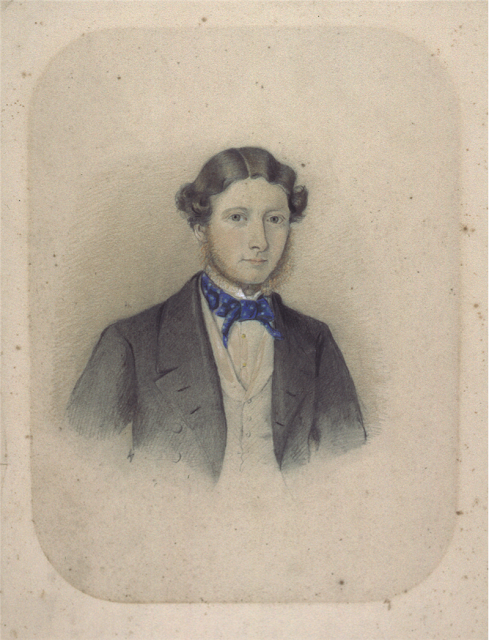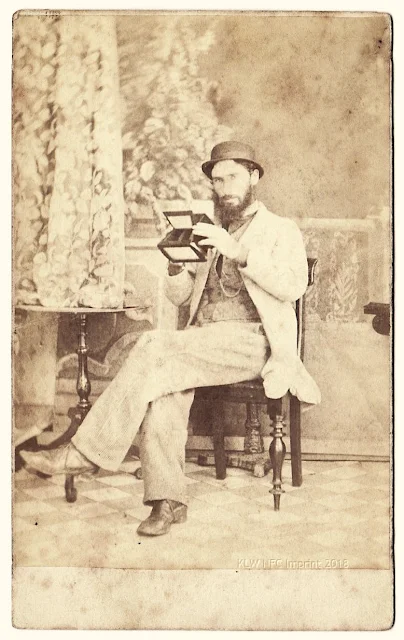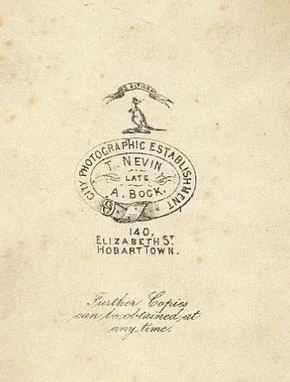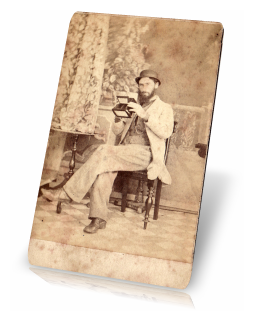MISATTRIBUTION in PRINT
Helen ENNIS (2000) and Isobel CROMBIE (2004).
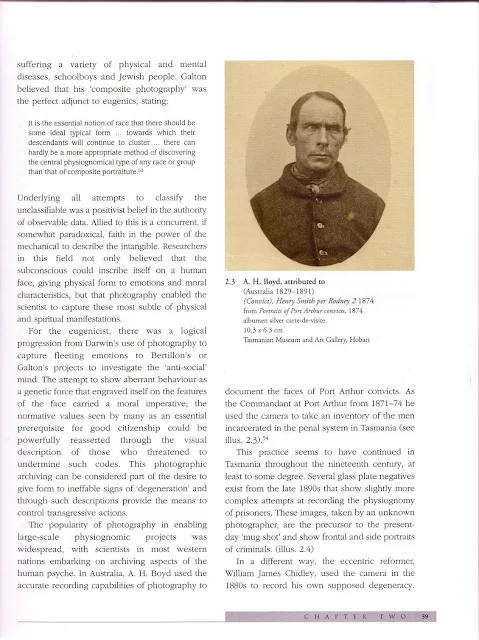
MISATTRIBUTION
Isobel Crombie's book, Body Culture: Max Dupain, Photography and Australian Culture, 1919-1939, published by the National Gallery of Victoria (2004) includes this original photograph of a Tasmanian prisoner taken by government contractor and professional photographer Thomas J. Nevin, dated 1874, with misattribution to the Port Arthur Commandant A. H .Boyd on page 39.
In a discussion which lies outside the dates of the book's title, Isobel Crombie attributes this carte-de-visite of convict Henry Smith per Rodney 2 to A. H. Boyd, an accountant promoted through nepotism to the position of Commandant of the Port Arthur prison site, a position he held until forced to resign in December 1873. A. H. Boyd had no reputation in his lifetime as a photographer, and no works in any genre by him are extant.
The caption here gives the photograph's provenance from the Tasmanian Museum and Art Gallery's collection called "Portraits of Port Arthur convicts." It bears the number "128" directly below the oval image, a number which is absent on both the Archives Office of Tasmania (AOT) and Crombie's reproductions, which suggests it was copied either by Beattie ca 1916 when he lodged duplicates of Nevin's prisoner photographs with the State Museum (i.e. TMAG), or it was copied from the QVMAG Beattie collection for display at the Port Arthur Heritage Site in 1983-1984. Together with 50 or more sourced from the QVMAG for that exhibition at Port Arthur, they were not returned to the QVMAG in Launceston; they were deposited instead with the TMAG in Hobart.

Tasmanian Museum and Art Gallery catalogue with the Boyd misattribution:
Ref: Q15594
ITEM NAME: Photographic print:
MEDIUM: Albumen silver carte de visite,
MAKER: A H Boyd [Artist];
TITLE: '[Convict]: "128" "Henry Smith per Rodney 2 / Taken at Port Arthur 1874"
DATE: 1874
HISTORY: It is thought that the commandant of Port Arthur, A H Boyd may have taken the convict photographs at Port Arthur. Boyd was a very keen amateur photographer and is known to have had a room at Port Arthur fitted up in his garden as a studio and darkroom. Notes contained in the Mitchell Library's Tasmanian Papers refer instructions given to Boyd to photograph the convicts prior to the closure of Port Arthur and to photographic equipment sent to Boyd in 1873.
The last paragraph, "HISTORY" is based solely on hearsay, rumour and speculation. Whoever wrote the caption to this photograph at the TMAG had not sighted the Mitchell Library documents. There is no document held at the State library of NSW which instructs A. H. Boyd to photograph convicts at Port Arthur. There is only a memo from the Colonial Secretary held in the Archives Office of Tasmania requesting photographs of absconders, dated January 1874. It in no way instructs Boyd personally to take photographs of prisoners himself. Those photographs of prisoners already in existence by December 1873 were taken by Thomas J. Nevin at the Port Arthur prison and at the Hobart Gaol, Campbell Street. Nevin was contracted by the Attorney-General R. W. Giblin to commence the provision of prisoner identification photographs from early 1872 on receiving advice of the former Premier of Victoria and the Solicitor-General while on a visit to Tasmania in January 1872. Nevin was contracted on that occasion to photograph the group on trips to Adventure Bay and Port Arthur.
REPEAT OFFENDERS
The photograph of prisoner Henry Smith per Rodney 2 is a copy of an albumen silver carte-de-visite (10.3 x 6.3cm) produced as a mugshot within conventional commercial practice. Another copy is held at the Archives Office of Tasmania (webshot below) with the historically correct attribution to Thomas Nevin, among at least 200 dated verso with the later incorrect transcription, "Taken at Port Arthur 1874".

PH30/1/3260; Title: Henry Smith
Date: 1874; Convict, transported per Rodney.
Photograph taken at Port Arthur by Thomas Nevin
In the accompanying text in her publication, Isobel Crombie states:
The popularity of photography in enabling large-scale physiognomic projects was widespread, with scientists in most western nations embarking on archiving aspects of the human psyche. In Australia, A. H. Boyd used the accurate recording capabilities of photography to document the faces of Port Arthur convicts. As the Commandant at Port Arthur from 1871-74 he used the camera to take an inventory of the men incarcerated in the penal system in Tasmania ... [note54].Isobel Crombie makes a fundamental error in this statement. She assumes an ethnographic purpose underlined the photographic documentation of Tasmanian prisoners in the 1870s, and completely ignores the most obvious purpose, viz. the pressing need for police to acquire accurate identification methods on a daily basis to keep track of habitual and repeat offenders at large. These photographs by Nevin were mugshots, taken on commission for police and prison authorities, most at the trials in the Supreme Court, and for the same reasons the police use identification photographs - mugshots - today. Thomas Nevin would have displayed these prisoner mugshots for the public to view at the Municipal Police Office, the central registry of criminal records at the Town Hall from the beginning of his commission in early 1872 and where he assumed full-time civil service as Town Hall Keeper from 1876 to 1880. He may have even displayed a few in his studio shop window while still working from his studio in Elizabeth Street, especially in the case of absconders from servitude.
POLICE NOTICES for Henry Smith per Rodney 2
The subject of this mugshot, Henry Smith, repeatedly offended in the 1870s. The weekly police gazettes published these notices:

Notice of arrest of Henry Smith per Rodney 2 was published in the police gazette of 18th August 1871. He was sentenced to 5 yrs for housebreaking at the Supreme Court, Hobart Town on 12 September 1871.

Henry Smith absconded and was arrested, per this notice published on October13, 1871

Source: Tasmania Reports of Crime Information for Police James Barnard Government Printer.
Henry Smith was arrested on 13th April 1873 at Oatlands, received at the Hobart Gaol and photographed by Thomas J. Nevin on arrival. Henry Smith was discharged on 13th September 1876.
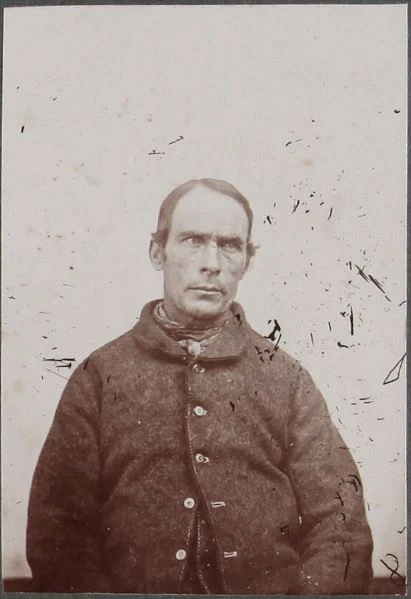
Above: The original photograph of prisoner Henry Smith printed by Thomas J. Nevin from his negative, 1873.
One of forty prints of 1870s Tasmania prisoners in three panels
Original prints of negatives by T. J. Nevin 1870s
Reprised and offered for sale by J. W. Beattie ca. 1915-1916
QVMAG Collection: Ref : 1983_p_0163-0176
THE BACKSTORY
Isobel Crombie's misinformation and misattribution can be traced back to two earlier sources:
1. Helen Ennis' use of the TMAG catalogue entries of their Port Arthur convicts as curator of the National Portrait Gallery's exhibition, "Mirror with a Memory" in 2000. Note 54 to the Crombie chapter gives the following:
54. Ennis, Mirror with a memory: Photographic Portraiture in Australia , p.16, fn. 45, p.44.2. The Tasmanian Museum and Art Gallery's error in attributing their holdings of several 1870s photographs of Tasmanian prisoners to A. H. Boyd instead of T. J. Nevin, an error which persisted with confusion in their 1995 publication Tasmanian Photographers 1840-1940: A Directory (ed. G. Winter). In that publication, writer Chris Long cites three way bills - lists of passengers and cargo travelling to and from Port Arthur on the government schooner Harriet as evidence that Boyd was the likely photographer in 1874 (1995:36). A. H. Boyd was a career accountant from 1853. He was sacked from the position of Superintendent at the Orphan School, New Town, for bullying and misogyny, and forced again to resign from the position of Commandant at Port Arthur for corruption in December 1873. As an accountant, Boyd merely signed documents to pay for the site's operation. His signature can also be found on documents pertaining to the exhibition of cabinetry and shoes made by convicts at the Port Arthur prison: does that make him a carpenter and shoemaker too?
A close examination of the original way bills cited by Long and held at the Mitchell Library (SLNSW) gives no indication in any sense that Boyd was the photographer. The photographic equipment on two way bills went into government stores. The third and last way bill cited by Long (dated 2nd April 1874) purportedly shows that a photographer's tent was shipped back to Boyd as personal property in Hobart after his term of service at Port Arthur expired (Long, 1995: 36), which is a curious state of affairs for government stores property. The document actually shows only a few feminine items belonging to a Mrs Boyd that were amongst the cargo that day. The tent was simply listed amongst other cargo. It probably belonged to Samuel Clifford who photographed the site's buildings and landscapes in 1873 or to Thomas Nevin who visited the site regularly with both Alfred Bock and Samuel Clifford. His visit on May 8th, 1874 was significant because he accompanied William Campbell, whose photograph in the NLA Collection is one of the more remarkable for being hand-tinted. Campbell was hanged a year later at the Hobart Gaol under the name "Job Smith".
To enhance the totally improbable story that A. H. Boyd was the photographer of "convict" portraits taken in the 1870s which bear the inscription "Taken at Port Arthur 1874" verso, which was probably written by Beattie who touted them to tourists in the 1900s, Chris Long cites two circumstantial pieces of "evidence":
1. There is ONE photograph supposedly taken by A.H. Boyd held at the Mitchell Library, SLNSW, according to Chris Long. However, in every instance when writers about this so-called "mystery" of authorship engage in the discussion, no one has actually obtained and cited a catologue number for that particular photograph, and no one has given a description of the subject of that one photograph. It is in fact a reprint by the Anson Bros. of a building at Port Arthur, not of a man in prison clothing, and it is dated 1894: someone has pencilled Boyd's name on the mount. It looks most suspiciously like a fake inscription written in a modern hand, to mislead researchers idto believing Boyd actually photographed something or someone when nothing at all exists that can be proven to be his photographic work. The only document listed with A.H. Boyd's name in the SLNSW catalogue of MS and pictures is his pencilled name on his copy of Rocher's rules of convict discipline dated 1839.
Furthermore, the Mitchell Library SLNSW holds a vast collection of original documents from the Tasmanian colonial period - 368 volumes - bequeathed by D. S. Mitchell in 1907, including a later acquisition from photographer John Watt Beattie (1919) from whose bequest in the QVMAG the Nevin portraits of convicts were drawn for exhibition (1977) and distributed piecemeal to other State and National institutions (e.g. AOT, NLA and TMAG 1987).
MITCHELL LIBRARY SLNSW
Title : Tasmanian Papers, 1803-1890, re the administration of the Tasmanian convict system
Creator : Tasmania. Government
Date of Work : 1803-1890
Contents : Official records relating to the government and administration of Tasmania. The records relate to both free citizens and convicts and include material as diverse as jury lists, correspondence, supreme court records, police records, convict indents, convict returns and convict assignment lists, musters, land grants, financial records, Commisariat records, executive council minutes, stock and produce returns, magisterial records, marriage records, plans etc.
Title : Tasmanian Papers, 1821-1877, bequeathed by D.S. Mitchell, 1907 [87 vols. from a series of 368 vols.]
Date of Work : 1821 - 1877
Type of Material: Manuscripts
Bequeathed by D. S. Mitchell, 1907 (Tas. Papers Nos 16, 21-30, 129-141, 161-174, 198, 209-211, 221, 229, 233, 247-251, 294-302, 305-308, 310-314, 316, 318-321, 332, D 2-D 13, D 23).
Other volumes were acquired from Angus & Robertson, 1911,1913, Mr Beattie, 1919, Mr. Eldershaw, 1939, C.R. Fisher, 1946, C.L. Wilkes, 1949 and C.H. Lucas, 1954.
Mitchell Collection State Library of NSW
Photo copyright © KLW NFC 2009 ARR
Any researcher on this question of "authorship" - which is a debate amongst art historians founded on essentialist notions of the "artist" - needs to examine the Mitchell holdings: to imagine that the only extant records relevant to the period are held by Tasmanian institutions and Tasmanian historic sites, is indeed naive. There are eleven photographs of Tasmanian prisoners taken in the 1870s by Thomas J. Nevin held at the Mitchell Library NSW, two of which bear his Royal Arms colonial warrant studio stamp. These Tasmanian prisoners were not photographed because they were transported convicts per se as some sort of ethnographic portfolio, a notion often applied by social anthropologists to photographs of Aborigines of the period. They were photographed because they were repeat offenders, recidivists and habitual criminals who earned a further sentence in the Supreme Court and a mugshot.
2. There is ONE photograph supposedly by A.H. Boyd held at the TMAG. Again, no catalogue number is cited. No subject of the supposed photograph is described when cited by the Boyd apologists. There is one photograph taken by Charles A. Woolley of a man whom Chris Long claims to be A. H. Boyd (published in the TMAG Directory 1995:129). It looks like an early photograph of a young man, too young to be A.H. Boyd in 1874, and as Woolley had wound down his photographic operations by about 1870, the photograph must have been taken elsewhere and in the 1860s. There is another photograph of a man who looks very similar but ten years older which was taken by Thomas J. Nevin ca. 1876, and which bears Nevin's studio stamp with the government Royal Arms insignia on verso (Personal Collection of G. T. Harrisson).
Why foist this nonsense onto Boyd, then, who has no extant work and had no reputation as a photographer in his lifetime, when government contracts issued to professional photographers for prison photography was already common practice in South Australia, NSW, and Victoria?
FICTION CANNOT be USED as PROOF of HISTORICAL FACT
A story circulated at the Port Arthur Historic site in the 1980s that a descendant of A. H. Boyd recalled seeing a camera at the Commandant's House. This is the source of the Boyd misattribution manufactured by Chris Long which referenced statements that historian Margaret Glover did NOT make in her article on Port Arthur experiments (1979). Chris Long's research strategy was to approach descendants for information about the family collections (Nevin family included -1984) regardless of their wishes.
The Boyd descendant was a niece, E.M. Hall, whose so-called "remininences" about her uncle at Port Arthur was in reality a children's fictional tale about a holiday which was submitted in typescript to the State Library in 1942. The story mentions neither Boyd by name nor the photographing of prisoners. The construction of A. H. Boyd as the photographer of prisoners, which was repeated by Warwick Reeder again in 1995 (MA thesis ANU, page 69) was - and still is - founded on hearsay about the presence of a camera on the site - nothing more substantial than that. Hearsay, of course, is a legally discredited term. By the 1880s, when the Commandant's House had become the Carnarvon Hotel, there were several photographers and cameras on site to supply the tourists with a memento of their visit. This is one example by A. Sargeant ca. 1885, also from the TMAG, and it correlates with the imagery in E.M. Hall's story, a place which by 1880 was a deserted ruin:
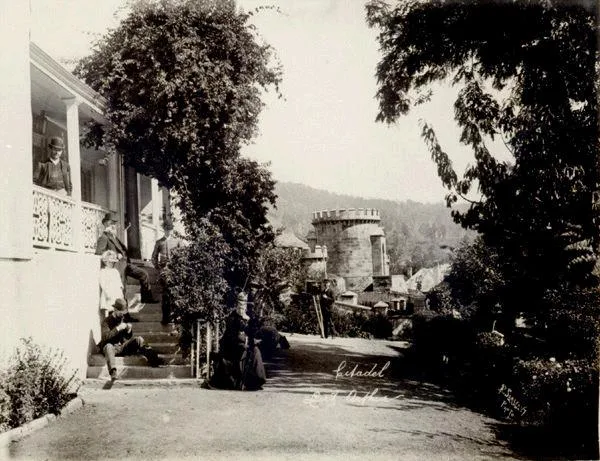
Tasmanian Museum and Art Gallery Q1998.25.5
ITEM NAME: Photographic print in album:
MEDIUM: gelatin silver print toned,
MAKER: A Sargeant [Artist];
TITLE: 'Citadel Port Arthur. A Sargeant Photo 89'
DATE: 1885 c
The inscription "Taken at Port Arthur 1874" appears on the verso of several of the convict cdv's held in public collections. The handwriting is consistent and similar across all these prisoner photographs from the 1870s, and is consistent with handwriting styles of the 1920s.
A remarkable oversight by Chris Long - if he saw the original way bills at the Mitchell - is the presence of a Mr Clifford on the passenger list for the government schooner Harriet's way bill dated July 30th 1873. He was indeed the photographer Samuel Clifford on his way to photograph the general degradation of the site, the buildings in disrepair and the underdeveloped surrounding landscape, at the behest of the parliament questioning the outrageous cost of maintaining the site, and the misappropriation of government resources by its Commandant A. H. Boyd in collusion with public works administrator Mr. Cheverton.
On board the schooner Harriet on its way to Port Arthur that day in July 1873 was a listed cargo of 288 photographic glasses, which may have been intended for any or several purposes. Many of Clifford's photographs of Port Arthur taken in 1873 are held at the State Library of Tasmania. The cargo of 288 glass plates supposedly shipped there in July 1873 reflects the photographic difficulties of the era - accidents, mistakes, breakage, clouding and dirt. The number of plates in no way bears any correlation to the number of inmates at Port Arthur in July 1873; by 1871 there were fewer than 109, and by 1873 even fewer. Having started the transfer back to the Hobart Gaol and other municipal asylums in Hobart by 1871, the colonial government was intent on closing Port Arthur because of the corrupt practices of its administrators - A.H. Boyd in particular - who bolstered the numbers of inmates by whatever artificial means to arrest the site's closure and thereby protect his well-heeled existence as the brother-in-law of the Attorney-General W.R. Giblin.
Professional photographers Samuel Clifford and Thomas J. Nevin used a joint signature - "Clifford & Nevin, Hobart Town" - on several photographs they produced while in partnership. They toured the island of Tasmania in 1874, Clifford producing commercial views for sale while Nevin visited regional police offices on government business. Clifford also copied and printed Nevin's stereographs in the late 1870s. Thomas Nevin, with his younger brother Constable John Nevin (1851-1891) who was salaried with H.M. Gaol, worked principally as a team under contract as prison photographers between 1873-1884, and there is also evidence of Thomas Nevin's earlier presence there in the late 1860s, just as there is evidence of his presence at the Port Arthur prison in May 1874 when Dr Coverdale had become Commandant Surgeon of the site, and when the transfer of prisoners to Hobart was almost complete.
Thomas J. Nevin's commercial cohort and close associates were Morton Allport, Alfred Bock, George Cherry, Samuel Clifford, Charles A. Woolley, Alfred Winter, and particularly Henry Hall Baily whose studio was opposite Nevin's in Elizabeth St. and who was out with him that fateful night in December 1880 when Nevin was detained on suspicion of pretending to be a ghost. The ghost was not caught, but propinquity would suggest that it was Mr Edwin Midwood, the Information Officer at the Town Hall Police Office, or his famous cartoonist son Thomas Midwood, who would publish that same year a caricature of Police Superintendent Propsting.

Henry Hall Baily's stamp Elizabeth St. 1860s
Henry Hall Baily did not receive official government endorsement until the 1880s, and no association has been established between Samuel Clifford and the photographing of convicts. Misattributions still persist with these 1870s photographs of Tasmanian prisoners. The National Library of Australia calls them "portraits" as though they were aesthetic objects, and has been misled into adding A.H. Boyd's name to each photographic record under pressure from the commercially driven interests of the Port Arthur Historic Site Management Authority. However, it is not good enough that Ennis and Crombie failed to check the history of the seminal exhibition in 1977 of Port Arthur convict photographs by Thomas J. Nevin at the QVMAG. No acknowledgement was extended to work of the original curator John McPhee, nor to the publications by researchers Geoff Stilwell and Joan Kerr in 1992 when Helen Ennis and Isobel Crombie used these prisoner cdv's to inflect a postmodernist discursive turn of power differentials as their preferred interpretation.

Above: QVMAG press release 9th March 1977. John McPhee curator.
RELATED POSTS main weblog

